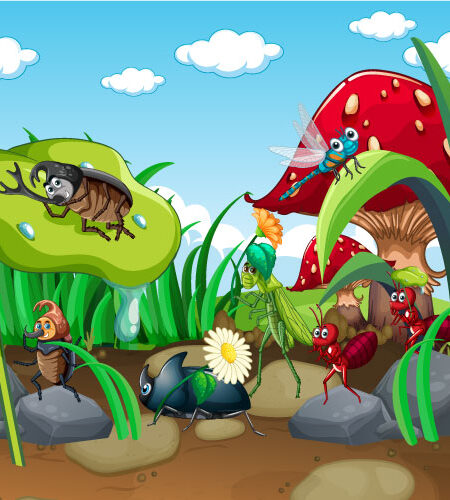Table of Contents
Introduction:
Insect animals, with their incredible diversity and fascinating adaptations, comprise a vast and intricate world that often goes unnoticed. From the buzzing of bees to the delicate flutter of butterflies, these creatures play integral roles in ecosystems worldwide. Let’s embark on a journey to explore the captivating realm of these small yet mighty inhabitants of our planet.
Insects, with their diverse shapes, behaviors, and habitats, form a fascinating tapestry of life on Earth. Let’s delve into the captivating realm of these incredible creatures:
Coloring insects
Bee: The Industrious Pollinator
Bees, with their vital role in pollination and honey production, symbolize diligence and contribute significantly to ecosystem health.

Spider: The Master Weaver
Spiders, known for their silk-spinning abilities and predatory nature, showcase incredible weaving skills and fascinating hunting techniques.

Snail: The Slow Mollusk
Snails, with their retractable eyes and unique shells, illustrate patience and adaptability while traversing various environments.

Cicada: The Melodious Singer
Cicadas, with their seasonal choruses, fill the air with buzzing songs, marking the arrival of warmer seasons in many regions.

Cockroach: The Resilient Survivor
Cockroaches, often disliked yet resilient, survive in diverse conditions, demonstrating adaptability and resourcefulness.

Beetle: The Diverse Inhabitant
Beetles, with their vast diversity in size and appearance, inhabit various ecosystems, showcasing incredible adaptability.

Scorpion: The Stinging Arachnid
Scorpions, with their venomous stings and nocturnal habits, epitomize stealth and efficient hunting in desert habitats.

Worm: The Subterranean Worker
Worms, essential to soil health, aid in decomposition and soil aeration, playing a crucial role in nutrient cycling.

Ant: The Social Collaborator
Ants, with their complex societies and organized colonies, symbolize teamwork and cooperation in achieving common goals.

Dragonfly: The Agile Flyer
Dragonflies, with their aerial acrobatics and iridescent wings, showcase remarkable agility in capturing prey.

Butterfly: The Graceful Transformer
Butterflies, with their colorful wings and transformative life cycle, symbolize beauty and metamorphosis in nature.

Ladybug: The Lucky Charmer
Ladybugs, with their bright spots and voracious appetite for pests, are seen as symbols of good luck in many cultures.

Millipede: The Multilegged Crawler
Millipedes, with numerous legs and segmented bodies, aid in decomposition, contributing to nutrient-rich soil.

Fly: The Agile Flyer
Flies, often misunderstood, serve as vital pollinators and decomposers, playing critical roles in various ecosystems.

Mosquito: The Bloodsucking Nuisance
Mosquitoes, while considered pests, play roles in ecosystems and are subjects of scientific study for disease prevention.

Caterpillar: The Larval Transformer
Caterpillars, before metamorphosing into butterflies or moths, exemplify growth and transformation.

Frog: The Amphibious Croaker
Frogs, though not insects, are integral to many ecosystems, symbolizing environmental health and adaptation.

Grasshopper: The Leaping Herbivore
Grasshoppers, with their powerful hind legs and herbivorous diet, signify agility and feeding diversity.

Tarantula: The Hairy Arachnid
Tarantulas, with their imposing size and hairy bodies, evoke fascination and fear in many people.

Each of these insect animals plays a unique and essential role in their respective ecosystems, contributing to the intricate web of life on our planet.
Importance:
Insects are pivotal to the functioning of ecosystems and hold immense significance for various reasons:
Pollination and Ecosystem Health: Bees, butterflies, and other pollinating insects contribute significantly to the reproduction of plants, ensuring food production and maintaining biodiversity.
Decomposition and Nutrient Cycling: Insects like worms, beetles, and flies play crucial roles in breaking down organic matter, aiding in nutrient recycling and soil health.
Food Web Dynamics: Insects serve as a primary food source for many animals, occupying essential positions in food webs and contributing to the balance of ecosystems.
Cultural Significance: Insects have cultural relevance in various societies, featuring in folklore, art, and symbolizing concepts like transformation, resilience, and luck.
Scientific Importance: Studying insects provides insights into biological diversity, evolutionary processes, and ecological interactions, contributing to scientific advancements and pest management strategies.
Indicator Species: Certain insects, like dragonflies and butterflies, serve as indicators of environmental health, reflecting changes in ecosystems due to factors like pollution or habitat loss.

Conclusion:
Insect animals, diverse and resilient, form the backbone of ecosystems, impacting our lives in myriad ways. Appreciating their importance in pollination, decomposition, and as foundational elements of food chains is crucial for understanding and preserving the delicate balance of nature. Protecting insect biodiversity, conserving habitats, and fostering awareness about their significance are vital steps toward safeguarding the health of our planet’s ecosystems. Let’s embrace the marvels of these tiny yet indispensable creatures and acknowledge their indispensable roles in the intricate web of life.
Play Time Color


Comments